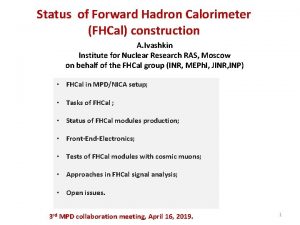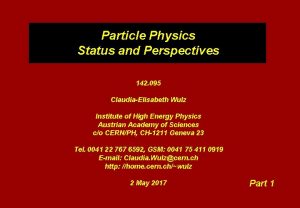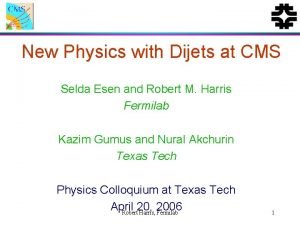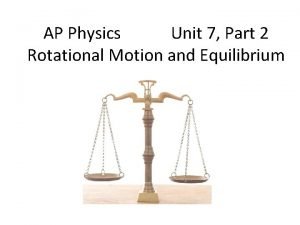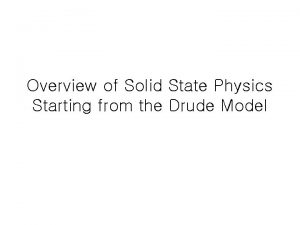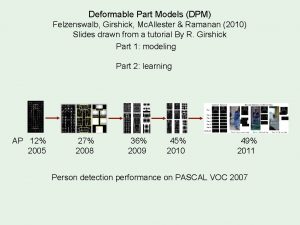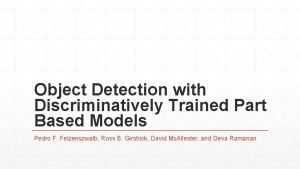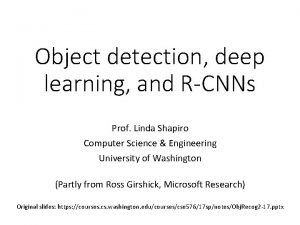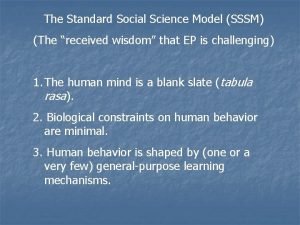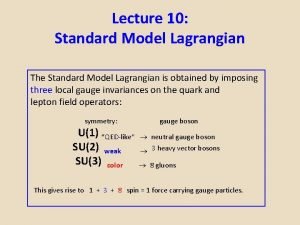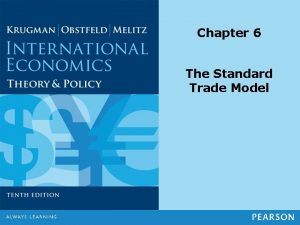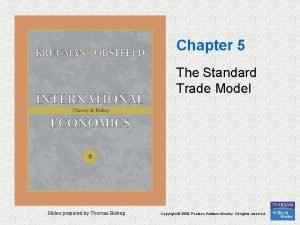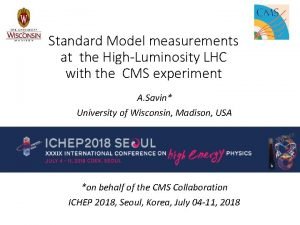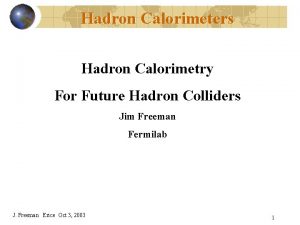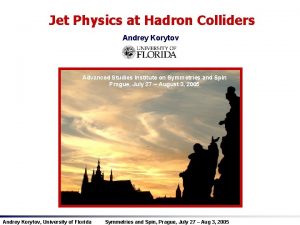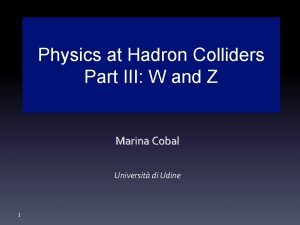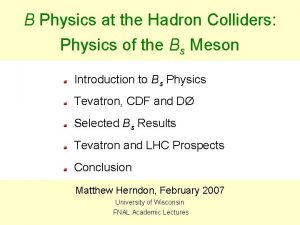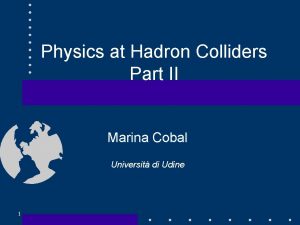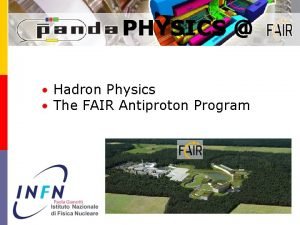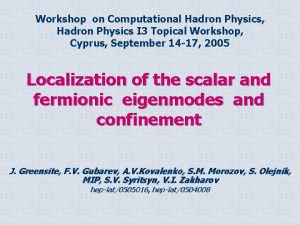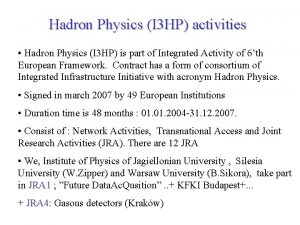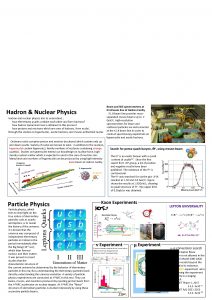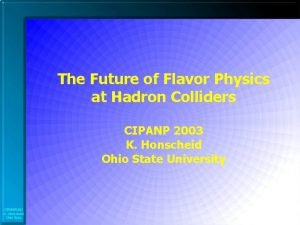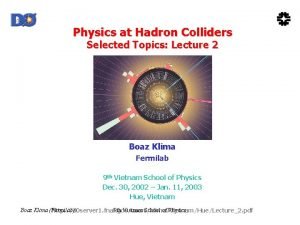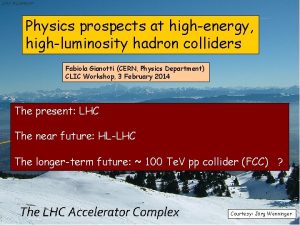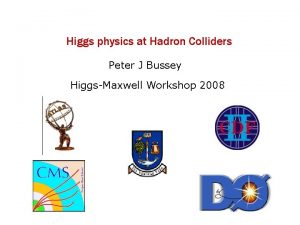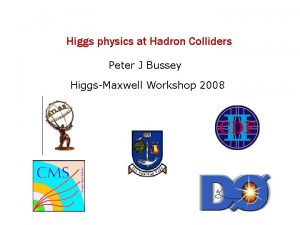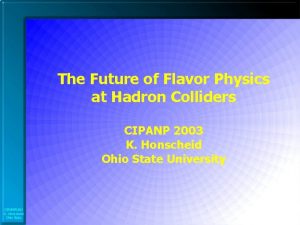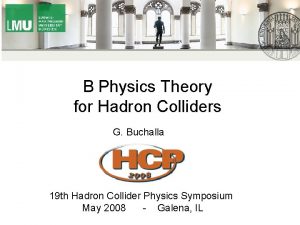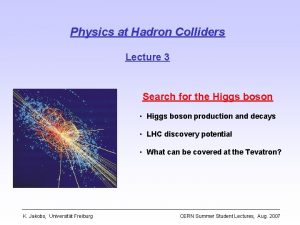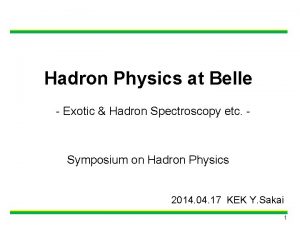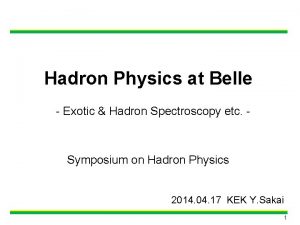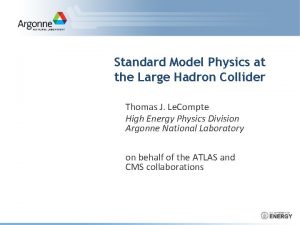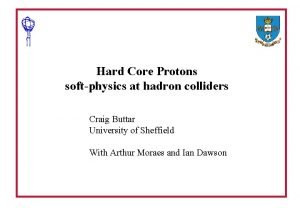Physics at Hadron Colliders Part 2 Standard Model











































- Slides: 43

Physics at Hadron Colliders Part 2 Standard Model Physics Test of Quantum Chromodynamics - Jet production - W/Z production - Production of Top quarks Precision measurements - W mass - Top-quark mass K. Jakobs, Universität Freiburg CERN Summer Student Lectures, Aug. 2006

QCD processes at hadron colliders • Hard scattering processes are dominated by QCD jet production • Originating from quark-quark, quark-gluon and gluon-gluon scattering • Due to fragmentation of quarks and gluons in final state hadrons → Jets with large transverse momentum PT in the detector • Cross sections can be calculated in QCD (perturbation theory) Comparison between experimental data and theoretical predictions constitutes an important test of theory. Deviations? → Problem in the experiment ? Problem in theory (QCD) ? New Physics, e. g. quark substructure ? K. Jakobs, Universität Freiburg CERN Summer Student Lectures, Aug. 2006

A two jet event at the Tevatron (CDF) Dijet Mass = 1364 Ge. V/c 2 ET = 666 Ge. V h = 0. 43 CDF (f-r view) ET = 633 Ge. V h = -0. 19 K. Jakobs, Universität Freiburg CERN Summer Student Lectures, Aug. 2006

A two jet event in the DØ experiment h f Mjj = 838 Ge. V/c 2 p. T(1) = 432 Ge. V/c p. T(2) = 396 Ge. V/c K. Jakobs, Universität Freiburg CERN Summer Student Lectures, Aug. 2006

Test of QCD Jet production Data from the DØ experiment (Run II) Inclusive Jet spectrum as a function of Jet-PT very good agreement over many orders of magnitude ! within the large theoretical and experimental uncertainties K. Jakobs, Universität Freiburg CERN Summer Student Lectures, Aug. 2006

Similar data from the CDF experiment contributions of the various sub-processes to the inclusive jet cross section Data corresponding to ~1 fb-1 Double differential distributions in PT and h

Main experimental systematic uncertainty: Jet Energy Scale • A Jet is NOT a well defined object (fragmentation, detector response) - one needs an algorithm to define a jet, to measure its energy (e. g. , a cone around a local energy maximum in the calorimeter, cone size adapted such that a large fraction of jet energy is collected, typical values: ΔR = √ ΔΦ 2 + Δη 2 = 0. 7 • Cone energy ≠ parton energy Main corrections: – In general, calorimeters show different response to electrons/photons and hadrons (see lectures on detector physics) – Subtraction of offset energy not originating from the hard scattering (inside the same collision or pile-up contributions, use minimum bias data to extract this) – Correction for jet energy out of cone (corrected with jet data + Monte Carlo simulations) K. Jakobs, Universität Freiburg CERN Summer Student Lectures, Aug. 2006

Main experimental systematic uncertainty: Jet Energy Scale Jet response correction in DØ: • measure response of particles making up the jet • use photon + jet data - calibrate jets against the better calibrated photon energy q g K. Jakobs, Universität Freiburg g q CERN Summer Student Lectures, Aug. 2006

Comparison with Theory – Fully corrected inclusive jet cross section Systematic uncertainties: - jet energy scale (red band) - parton density functions - theory: renormalization scale K. Jakobs, Universität Freiburg CERN Summer Student Lectures, Aug. 2006

Di-jet angular distributions: • reduced sensitivity to Jet energy scale • sensitive to higher order QCD corrections Good agreement with Next-to-leading order QCD-predictions K. Jakobs, Universität Freiburg CERN Summer Student Lectures, Aug. 2006

Test of W and Z production Number of detected W-bosons: p p q q l W(Z) n (l) Drell-Yan production process (leading order) Tevatron: expected rates for 2 fb-1: LHC: expected rates for 10 fb-1: K. Jakobs, Universität Freiburg 3 Mio W → ℓ events 60 Mio W → ℓ events CERN Summer Student Lectures, Aug. 2006

How do W and Z events look like ? As explained, leptons, photons and missing transverse energy are key signatures at hadron colliders → Search for leptonic decays: W → ℓ Z →ℓℓ (large PT (ℓ ), large PTmiss) A bit of history: one of the first W events seen; UA 2 experiment W/Z discovery by the UA 1 and UA 2 experiments at CERN (1983/84) K. Jakobs, Universität Freiburg CERN Summer Student Lectures, Aug. 2006

Today’s W / Z → e / ee signals CDF Trigger: • Electron candidate > 20 Ge. V/c Electrons • Isolated el. magn. cluster in the calorimeter • PT> 25 Ge. V/c • Shower shape consistent with expectation for electrons • Matched with tracks Z ee • 70 Ge. V/c 2 < mee < 110 Ge. V/c 2 W e • Missing transverse momentum > 25 Ge. V/c missing transverse momentum PTmiss (Ge. V/c) K. Jakobs, Universität Freiburg CERN Summer Student Lectures, Aug. 2006

Z→ ℓℓ cross sections Good agreement with NNLO QCD calculations C. R. Hamberg et al, Nucl. Phys. B 359 (1991) 343. Precision is limited by systematic effects (uncertainties on luminosity, parton densities, . . . )

W ℓ Cross Section Note: the longitudinal component of the neutrino cannot be measured → only transverse mass can be reconstructed K. Jakobs, Universität Freiburg Good agreement with NNLO QCD calculations C. R. Hamberg et al, Nucl. Phys. B 359 (1991) 343. Precision is limited by systematic effects (uncertainties on luminosity, parton densities, . . . ) CERN Summer Student Lectures, Aug. 2006

Comparison between measured W/Z cross sections and theoretical prediction (QCD) C. R. Hamberg, W. L. van Neerven and T. Matsuura, Nucl. Phys. B 359 (1991) 343 K. Jakobs, Universität Freiburg CERN Summer Student Lectures, Aug. 2006

QCD Test in W/Z + jet production Z + 1 jet Z + 2 jets Z + 3 jets Compare # of W/Z + n jet events (data versus QCD Monte Carlo Models -SHERPA, ALPGEN-) K. Jakobs, Universität Freiburg CERN Summer Student Lectures, Aug. 2006

Top Quark Physics • Discovered by CDF and DØ collaborations at the Tevatron in 1995 • Run I top physics results are consistent with the Standard Model (Errors dominated by statistics) • Run II top physics program will take full advantage of higher statistics - Better precision - Search for deviations from Standard Model expectations K. Jakobs, Universität Freiburg CERN Summer Student Lectures, Aug. 2006

Why is Top-Quark so important ? • The top quark may serve as a window to New Physics related to the electroweak symmetry breaking; Why is its Yukawa coupling ~ 1 ? ? • We still know little about the properties of the top quark: mass, spin, charge, lifetime, decay properties (rare decays), gauge couplings, Yukawa coupling, …

Top Quark Production Pair production: qq and gg-fusion qq gg s (pb) Run I 1. 8 Te. V Run II 1. 96 Te. V LHC 14 Te. V 90% 10% 85% 15% 5% 95% 5 pb 7 pb 600 pb K. Jakobs, Universität Freiburg Electroweak production of single top-quarks (Drell-Yan and Wg-fusion) s (qq) (pb) s (g. W) (pb) s (gb) (pb) Run I 1. 8 Te. V Run II 1. 96 Te. V LHC 14 Te. V 0. 7 1. 7 0. 07 0. 9 2. 4 0. 1 10 250 60 CERN Summer Student Lectures, Aug. 2006

Top Quark Decays BR (t→Wb) ~ 100% Both W’s decay via W ℓ (ℓ=e or ; 5%) dilepton channel One W decays via W ℓ (ℓ=e or ; 30%) lepton+jets lepton + jet channel Both W’s decay via W qq (44%) all hadronic, not very useful Important experimental signatures: : - Lepton(s) - Missing transverse momentum - b-jet(s) K. Jakobs, Universität Freiburg CERN Summer Student Lectures, Aug. 2006

DØ top candidate event with two leptons p. T(e) = 20. 3 Ge. V/c 2 p. T( ) = 58. 1 Ge. V/c 2 ETj = 141. 0, 55. 2 Ge. V ET=91 Ge. V K. Jakobs, Universität Freiburg CERN Summer Student Lectures, Aug. 2006

tt cross section (dilepton) l v 2 high-p. T isolated leptons W 2 jets Large missing ET , W l hep-ex/0505082 L=230 pb-1 (stt=7 pb) v t t B-jet

A CDF Lepton + Jet event ℓ jet n b-jet Lego view b-jet Jet 3 Jet 2 Jet 1 Jet 4 µ • muon • electron • photon K. Jakobs, Universität Freiburg p. T( ) = 54. 4 Ge. V ETj = 96. 7, 65, 8, 54. 8, 33. 8 Ge. V Missing ET= 40. 2 Ge. V CERN Summer Student Lectures, Aug. 2006

tt cross section (lepton + jets) (topology, no b-jet identification) 1 high-p. T isolated lepton 3 jets Large missing ET l v W W t t B-jet HT = scalar sum of all high PT objects (jets, leptons, ETmiss) Before b-tagging: background from W+jet events clearly dominates K. Jakobs, Universität Freiburg CERN Summer Student Lectures, Aug. 2006

Tagging of b-quarks Soft lepton tagging Search for non-isolated soft lepton in a jet K. Jakobs, Universität Freiburg Silicon Vertex tag B mesons travel ~ 3 mm before decaying: – Search for secondary vertex CERN Summer Student Lectures, Aug. 2006

Silicon detectors Run II: silicon detectors cover a large region of acceptance Bs J/Y f N = 133 17 K. Jakobs, Universität Freiburg CERN Summer Student Lectures, Aug. 2006

m - + jets double-tagged event B tagging established in both experiments! m. SV Important for the top physics measurements Jet 2 IP SV Jet 11 K. Jakobs, Universität Freiburg CERN Summer Student Lectures, Aug. 2006

tt cross section (lepton + jets) (including b-tagging) 1 high-p. T isolated lepton, at least one b-tagged jet Large missing ET hep-ex/0504058 1 secondary vertex tag L=230 pb-1 Control region Signal region Excess above the W+ jet background in events with high jet multiplicity K. Jakobs, Universität Freiburg CERN Summer Student Lectures, Aug. 2006

tt cross section (lepton + jets) (including double b-tag) 1 high-p. T isolated lepton + Two b-tagged jet Large missing ET Very clean top sample K. Jakobs, Universität Freiburg CERN Summer Student Lectures, Aug. 2006

tt cross section summary (preliminary) QCD prediction: - Cacciari et al. , hep-ph/0303085 - Kidonakis et al. , hep-ph/0303086 Good agreement among various exp. measurements and with QCD prediction (similar results for DØ) K. Jakobs, Universität Freiburg CERN Summer Student Lectures, Aug. 2006

Precision measurements of m. W and mtop Motivation: W mass and top quark mass are fundamental parameters of the Standard Model; The standard theory provides well defined relations between m. W, mtop and m. H Electromagnetic constant measured in atomic transitions, e+e- machines, etc. GF, αEM, sin θW are known with high precision Fermi constant measured in muon decay weak mixing angle measured at LEP/SLC K. Jakobs, Universität Freiburg radiative corrections r ~ f (mtop 2, log m. H) r 3% Precise measurements of the W mass and the top-quark mass constrain the Higgsboson mass (and/or theory, radiative corrections) CERN Summer Student Lectures, Aug. 2006

The W-mass measurement 4 • 10 -4 m. W (from LEP 2 + Tevatron) = 80. 410 0. 032 Ge. V mtop (from Tevatron) = 172. 5 2. 3 Ge. V 1. 4% light Higgs boson is favoured by present measurements Ultimate test of the Standard Model: comparison between the direct Higgs boson mass (from observation, hopefully) and predictions from rad. corrections…. K. Jakobs, Universität Freiburg CERN Summer Student Lectures, Aug. 2006

Technique used for W-mass measurement at hadron colliders: Event topology: DØ Observables: PT(e) , PT(had) PT( ) = - ( PT(e) + PT(had) ) long. component cannot be measured In general the transverse mass MT is used for the determination of the W-mass (smallest systematic uncertainty). K. Jakobs, Universität Freiburg CERN Summer Student Lectures, Aug. 2006

Shape of the transverse mass distribution is sensitive to m. W, the measured distribution is fitted with Monte Carlo predictions, where m. W is a parameter Main uncertainties: m. W= 79. 8 Ge. V m. W= 80. 3 Ge. V result from the capability of the Monte Carlo prediction to reproduce real life: • detector performance (energy resolution, energy scale, …. ) • physics: production model p. T(W), GW, . . . m. TW (Ge. V) • backgrounds Dominant error (today at the. Tevatron, and most likely also at the LHC) : Knowledge of lepton energy scale of the detector ! K. Jakobs, Universität Freiburg CERN Summer Student Lectures, Aug. 2006

Calibration of the detector energy scale: Example : EM calorimeter e- beam E = 100 Ge. V CALO Emeasured • if Emeasured = 100. 000 Ge. V for all calorimeter cells calorimeter is perfectly calibrated • to measure m. W to ~ 20 Me. V, need to know energy scale to 0. 02%, i. e. if E electron = 100 Ge. V then 99. 98 Ge. V < Emeasured < 100. 02 Ge. V one of most serious experimental challenges !! K. Jakobs, Universität Freiburg CERN Summer Student Lectures, Aug. 2006

Calibration strategy: • detectors equipped with calibration systems which inject known pulses: in out cell check that all cells give same response: • calorimeter modules calibrated with test beams of if not correct known energy set the energy scale • inside LHC detectors: calorimeter sits behind Inner Detector electrons lose energy in material of Inner Detector need a final calibration “ in situ ” by using physics samples: e. g. Z e+ e- decays constrain mee = m. Z 1/s at low luminosity known to 10 -5 from LEP K. Jakobs, Universität Freiburg CERN Summer Student Lectures, Aug. 2006

What precision can be reached in Run II and at the LHC Int. Luminosity 0. 08 fb-1 2 fb-1 10 fb-1 Stat. error 96 Me. V 19 Me. V 2 Me. V Energy scale, lepton res. 57 Me. V 20 Me. V 16 Me. V Monte Carlo model (PTW, structure functions, photon-radiation…. ) 30 Me. V 20 Me. V 17 Me. V Background 11 Me. V 2 Me. V 1 Me. V Tot. Syst. error 66 Me. V 28 Me. V 24 Me. V Total error 116 Me. V 34 Me. V 25 Me. V ? • Total error per lepton species and per experiment at the LHC is estimated to be 25 Me. V at the Tevatron 34 Me. V • Main uncertainty: lepton energy scale (goal is an uncertainty of 0. 02 %) • Many systematic uncertainties can be controlled in situ, using the Z → sample (PT(W), recoil model, resolution) Combining both experiments (ATLAS + CMS, 10 fb-1), both lepton species and D m. W ~ 15 Me. V assuming a scale uncertainty of 0. 02% Tevatron: 2 fb-1: K. Jakobs, Universität Freiburg D mw ~ ± 30 Me. V CERN Summer Student Lectures, Aug. 2006

Signature of Z and W decays Z l+l– K. Jakobs, Universität Freiburg W ln CERN Summer Student Lectures, Aug. 2006

What precision can be reached in Run II and at the LHC Int. Luminosity 0. 08 fb-1 2 fb-1 10 fb-1 Stat. error 96 Me. V 19 Me. V 2 Me. V Energy scale, lepton res. 57 Me. V 20 Me. V 16 Me. V Monte Carlo model (PTW, structure functions, photon-radiation…. ) 30 Me. V 20 Me. V 17 Me. V Background 11 Me. V 2 Me. V 1 Me. V Tot. Syst. error 66 Me. V 28 Me. V 24 Me. V Total error 116 Me. V 34 Me. V 25 Me. V ? • Total error per lepton species and per experiment at the LHC is estimated to be 25 Me. V at the Tevatron 34 Me. V • Main uncertainty: lepton energy scale (goal is an uncertainty of 0. 02 %) • Many systematic uncertainties can be controlled in situ, using the Z → sample (PT(W), recoil model, resolution) Combining both experiments (ATLAS + CMS, 10 fb-1), both lepton species and D m. W ~ 15 Me. V assuming a scale uncertainty of 0. 02% Tevatron: 2 fb-1: K. Jakobs, Universität Freiburg D mw ~ ± 30 Me. V CERN Summer Student Lectures, Aug. 2006

Top mass measurements • Top mass calculation: – Kinematic fit under (tt) hypothesis l v W – compute likelihood for observed events as a function of the top quark mass Maximum likelihood → mtop W t Bjet Most precise single measurements: Lepton+jets ( 1 b-tag) mtop = 173. 4 ± 3. 5 (stat+JES) 1. 3 (syst) Ge. V/c 2 mtop = 170. 6 ± 4. 4 (stat+JES) ± 1. 4 (syst) Ge. V/c 2 • (CDF) (DØ) Reduce JES systematic by using in-situ hadronic W mass in tt events (simultaneous determination of mt and JES from reconstructed mt and MW templates) L=230 pb-1

Future Prospects for the top quark mass measurement 1. Channel dependence ? still statistically consistent results; full hadronic channel is difficult 2. Expected Tevatron precision (full data set): ± 1. 5 Ge. V/c 2 3. Expected LHC precision for 10 fb-1: < ~ 1 Ge. V/c 2 (Combination of several methods, maybe somewhat conservative)

Summary of the 2. Lecture • Hadron Colliders Tevatron and LHC play an important role in future tests of the Standard Model • Predictions of Quantum Chromodynamics can be tested in - High PT jet production - W/Z production - Top quark production - ……. • In addition, precise measurements of Standard Model parameters can be carried out. Examples: W mass can be measured to ~15 Me. V Top-quark mass to ~ 1 Ge. V Higgs mass constrained indirectly to ~ 25% K. Jakobs, Universität Freiburg CERN Summer Student Lectures, Aug. 2006
 Hadron calorimeter
Hadron calorimeter Hadron collider
Hadron collider Hadron collider
Hadron collider Hadrons
Hadrons Hadron
Hadron Physics standard model
Physics standard model Physics standard model
Physics standard model Why does it happen
Why does it happen University physics with modern physics fifteenth edition
University physics with modern physics fifteenth edition Physics ia examples
Physics ia examples Ap physics unit 7 mcq
Ap physics unit 7 mcq Part part whole addition
Part part whole addition Part to part ratio definition
Part to part ratio definition Part part whole
Part part whole What is a technical description
What is a technical description Footed ware glass types
Footed ware glass types The part of a shadow surrounding the darkest part
The part of a shadow surrounding the darkest part Two way anova minitab 17
Two way anova minitab 17 Module 3 topic 4 basic maneuvering steering and braking
Module 3 topic 4 basic maneuvering steering and braking Lane position 1-4
Lane position 1-4 Standard error definition
Standard error definition Standard language examples
Standard language examples Standard costing
Standard costing Bahagian pembangunan kurikulum dskp
Bahagian pembangunan kurikulum dskp Sector zone model
Sector zone model Drude model solid state physics
Drude model solid state physics Four part processing model for word recognition
Four part processing model for word recognition Four part processing model for word recognition
Four part processing model for word recognition Deformable part model
Deformable part model Deformable part model
Deformable part model Deformable part model
Deformable part model Deformable part model
Deformable part model Standard trade model
Standard trade model What is the standard social science model
What is the standard social science model Standard solar model
Standard solar model Standard model lagrangian
Standard model lagrangian Standard market model
Standard market model Standard model lagrangian
Standard model lagrangian Standard trade model
Standard trade model Standard model
Standard model Standard model of trade
Standard model of trade Standard urban model
Standard urban model Standard cost model
Standard cost model Standard model measurements
Standard model measurements
